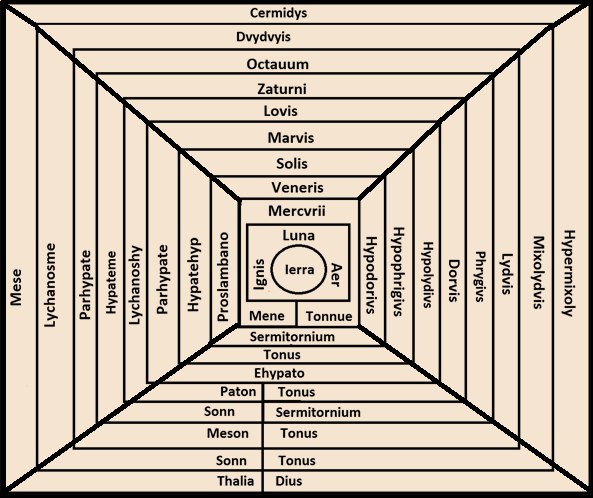Pantheon of Ierra
Although Kristyanitty is a common religion in Heimland, there are still sects of people who follow the ancient pagan religions that populated the island earlier.
Pagans in Heimland have no specific gods to worship, as there are millions of pagan deities in each region, and each region has their own god or goddess to worship. However, all pagans follow and acknowledge one specific pantheon: the pantheon of Ierra.
This pantheon is the oldest pantheon of Heimland. It focuses on one "family" of deities, all centered around the goddess Ierra. Each deity comes in its own avatar forms; their appearances range from animals to anthropomorphs to humanoids to inanimate objects.
Ierra, also known by her other name of Awen, is the central deity. She is the "mother" goddess, the one who birthed all the other gods and goddesses. Her children include:
- Luna- the moon god, appears as a large silver wolf. Aer- the wind god, appear as a pillar of wind. Ignis- the fire god, appears as a column of flaming earth.
- Mercvrii- child of Luna and god of sun, appears as a ball of rolling fire. Mene- child of Aer and goddess of water, appears as a watery bubble with all the colors of the rainbow. Tonnue- the child of Ignis and god of earth, appears as a large mountain with hundreds of legs.
- Hypodorvis- child of Mercvrii and Tonnue, god of lightning. He appears as a winged stallion with silver fur. Hypophrigivs- child of Hypodorvis, born through fission. The god of thunder. Appears as a large red fish with a large screaming mouth. Hypolydivs- child of Hypophrigivs, born through fission. The god of rain. Appears as a dancing elf holding a jar of water. Dorvis- child of Hypolydivs, born through fission. The goddess of fertility. Appears as a large rabbit. Phrygivs- child of Dorvis, born through fission. The goddess of plants and nature. Appears as a green-skinned maiden. Lydvis- child of Phrygivs, born through fission. The god of vitality. Appears as a large satin leopard. Mixolydvis- child of Lydvis, born through fission. The god of strength. Appears as a large black lion. Hypermixoly- child of Mixolydvis, born through fission. The god of youth. Appears as a child riding a massive horned bear.
- Proslambano- child of Mene and Mercvrii. God of war. Appears as a red buffalo. Hypatehyp- child of Proslambano, born through fission. Goddess of weaponry. Appears as a maiden wielding a sword. Parhypate- child of Hypatehyp, born through fission. God of chaos. Appears as a winged man. Lychanoshy- child of Parhypate, born through fission. God of space. Appears as a blue starfish. Hypateme- child of Lychanoshy, born through fission. God of stars. Appears as a giant blue wolf. Parhypate (II)- child of Hypateme, born through fission. God of wisdom. Appears as a giant green hawk. Lychanosme- child of Parhypate (II), born through fission. Goddess of animals. Appears as a large white tree. Mese- child of Lychanosme, born through fission. Goddess of music. Appears as a large songbird.
- Sermitornium- child of Mene and Tonnue. God of harvests. Appears as a man holding a scythe. Tonus- child of Sermitornium, born through fission. Goddess of rejuvenation and good luck. Appears as a woman holding a pair of balanced weighing-scales. Ehypato- child of Tonus, born through fission. God of food. Appears as a large flying pig. Paton- child of Ehypato, born through fission. Goddess of metals and chemicals. Appears as a large vessel of multicolored liquid. Tonus (II)- child of Ehypato, born through fission. God of medicine. Appears as a flowering herb-bush. Sonn- child of Paton and Tonus (II). God of healing and life. Appears as a sprouting oak-tree. Sermitornium (II)- child of Paton and Tonus (II). God of sacrifice. Appears as a white lamb. Meson- child of Sonn and Sermitornium (II). God of adventure. Appears as a large furry bull. Tonus (III)- child of Sonn and Sermitornium (II). Goddess of direction. Appears as a large brass statue with four arms pointing in four directions. Thalia- child of Meson and Tonus (III). Goddess of love. Appears as a coiled rope tying two trees together. Dius- child of Meson and Tonus (III). God of emotions (fear, anger, joy). Appears as a marble statue with many faces.
- Veneris- child of Mercvrii, born through fission. God of alchemy. Appears as a green lion. Solis- child of Veneris, born through fission. Goddess of enlightenment and messages. Appears as a grand eagle. Marvis- child of Solis, born through fission. God of sciences and mathematics. Appears as a large heron. Lovis- child of Marvis, born through fission. Goddess of physics and laws. Appears as a lage black cat. Zaturni- child of Lovis, born through fission. God of magic and metaphysics. Appears as a large winged lizard. Octauum- child of Zaturni, born through fission. Goddess of the supernatural and extraterrestrial. Appears as a grey humanoid. Dvydvyis- child of Octauum, born through fission. God of intelligence and virtue. Appears as a large tentacled entity. Cermidys- child of Dvydvyis, born through fission. Goddess of fate and destiny. Appears as a gigantic hawk covered with steel-blue feathers, with large green eyes on each feather.
Remove these ads. Join the Worldbuilders Guild










Comments